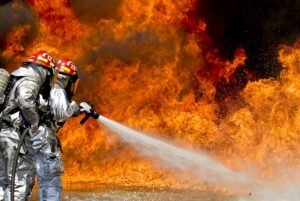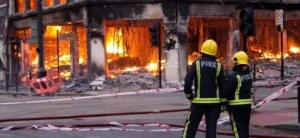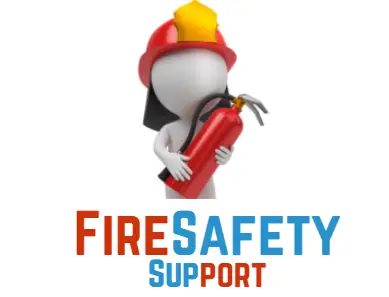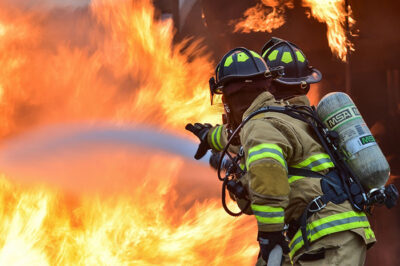You might not think of fire as a danger, but in fact, it can be quite harmful. Fire causes many different types of damage, including death and property loss. If you are around a fire, you can be seriously injured or even killed which is why you need to learn about fire safety. But before then you need to know ways to prevent and this post on what is fire prevention explains that.
Fire prevention is the practice of preventing fires from occurring in a building or other structure. It can be achieved by always having an escape plan, having the correct equipment and equipment maintenance, and training employees to use those tools correctly.
There are many different types of fire prevention measures, including:
Fire sprinklers: Water is forced through a sprinkler system to cool or extinguish fires that have started in a building. These systems can be expensive, but they’re good for reducing the risk of serious damage or loss of life.
Smoke detectors: These devices detect smoke in a building and alert people to the presence of fire. In addition to being able to detect smoke, smoke detectors can also detect carbon monoxide and flames.
Fire extinguishers: Fire extinguishers are designed to put out fires before they spread. It’s important to keep them properly maintained so they work effectively when needed.
What is fire safety and prevention?

Fire safety and prevention is the practice of preventing fires, reducing their severity, and reducing the amount of damage they cause. Fire safety and prevention can be achieved through a number of different practices.
Also, proper maintenance of building materials and equipment is key to preventing fires from occurring. It’s also important to have a fire escape plan in place and an evacuation route in case of emergency.
In addition, detecting fires early is also important because it gives people time to get out safely if there is an emergency. Some pieces of detection equipment include smoke detectors, carbon monoxide detectors, fire extinguishers, and water sprinklers.
Fire prevention in the workplace
In the workplace, there are many things that can go wrong. One of the most common accidents is a fire. There are thousands of people who have died from fires in their workplaces.
Also, fires are caused by many different things and it’s important that you take steps to prevent fires in your workplace.
The first step is to make sure that all combustibles are extinguished before leaving the premises. This includes candles, matches, and cigarettes. If you leave any of these items on a desk or table, they could cause an accident when you light them again after being away from work for some time.
Another way to prevent fires in the workplace is by using personal fire extinguishers instead of relying on company fire extinguishers which may not be as effective or reliable depending on where they are located within your facility (e.g., office vs factory floor).
In addition, employees should also know how to use these appliances so they can quickly put out small fires that might otherwise lead to bigger problems if left untreated for too long.
Furthermore, people should also wear fire-resistant clothing whenever possible so they can help prevent injuries if something goes wrong during an emergency situation at work.
Recommended: My Car Caught On Fire What Now?
What are the causes of fire?

The causes of fire can be split into two categories: accidental and intentional. Accidental fires are those caused by mechanical or electrical failure, while intentional fires are caused by arson.
However, here are some causes of the fire that you should know below:
1. Cooking Equipment
When cooking, it is necessary to use cooking equipment properly. Cooking equipment includes ovens, stovetops, microwave ovens, and stoves. These appliances must be maintained properly so that they will work safely and efficiently.
If these appliances are not maintained regularly or if they have been damaged in some way, then they could lead to a fire in your home.
In addition, if you notice any problems with your cooking equipment, such as cracks or paint chipping off of the appliance surface, then there is a high probability that this could result in an electrical short circuit and cause an electrical fire inside your home.
2. Heating Equipment
There are many causes of fire, but the most common are heating equipment malfunctions and electrical wiring problems.
Heating equipment malfunctions can be caused by both mechanical and electrical problems. Mechanical problems are typically the result of a buildup of mineral deposits on the heating coils or in the boiler chamber, which can reduce efficiency and cause a fire.
Electrical problems include loose electrical connections that can conduct electricity into a heating system and cause a fire when they arc or spark.
Although heating equipment is designed to be safe, it’s important to follow safety guidelines and avoid using heating equipment when you’re not in the home.
When you use heating equipment, make sure you have a working smoke alarm and that the power is off at all times. You should also make sure that any pets or children around are safely confined.
3. Careless Smoking
One of the most common causes of fire is careless smoking. It’s important to know that fire can happen anywhere at any time, but it’s especially dangerous if you’re smoking in a public place.
Smoking kills more than 1 million people each year, and it’s the leading cause of death from inhaling smoke. For those who don’t smoke, it’s also not a good idea to have matches or lighters around children or pets. Even if the child or pet doesn’t touch them, they could get their hands on them and start a fire.
4. Electrical Equipment
Electrical equipment is the cause of fire in most cases. It is responsible for over 90% of the fires that occur in homes. The most common cause of electrical fires is a short circuit, which occurs when two pieces of metal touch each other and create an electric current.
This can be due to faulty wiring or an appliance that has become unplugged or disconnected from its power source.
5. Candles
Candles are a great way to set the mood for a party, but they can also cause fires. They should never be lit within reach of children or pets or placed on furniture or other surfaces that could catch fire easily. If you have kids at home, consider buying only flame-resistant candles with wicks made from nontoxic materials like cotton or linen.
If you have pets, never leave lit candles unattended even if they’re flame-resistant. You never know what might happen if they escape their cage and start licking the wax off the candle’s surface.
6. Children Playing with Fire
One of the most common causes of fire is children playing with matches, lighters, and other flammable objects. When a child plays with fire, they’re not thinking. They are often just playing around and it’s likely that they don’t know how dangerous the object is.
Read:: Is Mineral Oil Flammable?
How do you control fire?
The best way to control fire is to avoid it. If you do not want to be in a burning building, don’t start a fire. If you do not want your house to burn down, don’t leave it unsecured.
Fire can be controlled in several ways: by extinguishing the flames with water or a fire extinguisher. Also, controlling fire is a very difficult task but it is something you can do. The first step to controlling fire is to understand the different types of fires and how they are controlled.
There are two basic types of fires:
-
Combustible Materials Fires:
This type of fire burns quickly destroys everything it touches, and can start in an instant. Examples include paper, oil and other flammable liquids, wood, clothing, and trash.
Solution: The best way to prevent this kind of fire is by keeping combustible materials away from other flammable materials.
-
Non-Combustible Materials Fires:
These types of fires damage only their surroundings, rather than destroying everything in their path as combustible materials fires do. Examples include furniture that catches on fire due to overheating or faulty wiring if it’s not connected properly; drywall that chars when exposed to high temperatures; and metal objects that burn when exposed to high temperatures (such as hot stovetop burners).
Solution: The best way to prevent this type of fire is by keeping non-combustible materials away from heat sources that could ignite them (like a hot stovetop burner or candle flame).
Why is fire prevention so important?

Fire prevention is so important because fires can cause a lot of damage to your home and belongings. The best way to prevent fires is to learn how they start and what you can do to prevent them from spreading.
It is also important because it helps you live in a safe, comfortable home Fire prevention is so important because fires can cause a lot of damage to your home and belongings. The best way to prevent fires is to learn how they start and what you can do to prevent them from spreading.
It is also important because it helps you live in a safe, comfortable home without worrying about waking up one morning to find that the house has been destroyed by a fire.
In addition to these reasons, there are many reasons why fire prevention is important:
- It keeps your family and loved ones safe from harm by making sure they are not in an area that has been designated as being dangerous due to high-risk conditions or materials being present in the building.
- It protects your neighbors from unnecessary stress caused by having a fire on their property.
- It prevents children from playing with matches or other dangerous items.
- It prevents the call for firefighters
Read:: Is Fart Flammable?
Ways to prevent fire in your workspace
To prevent fire in your workspace, you need to be able to identify the dangers. This can be done by using fire extinguishers and having an evacuation plan.
Fire extinguishers are a must-have in any workplace. They can be found at any hardware store and are easy to use. The most important thing is to make sure that everyone knows how to use them properly.
An evacuation plan should also be part of the workplace’s safety guidelines. This will allow everyone to leave safely if there is a fire or other emergency situation in the building.
1. Access to fire extinguisher
Having access to a fire extinguisher is the best way to prevent fires in your workspace. Whether you’re in an office or at home, you should have one handy and it should be clearly marked so that everyone knows where it is and how to use it.
2. Proper Disposal
The best way to prevent a fire in your workspace is to make sure that all of your materials are disposed of properly.
Here’s what you should do:
1) Dispose of all materials that could be flammable by putting them in a container with a lid and sealing it.
2) Then, put the container in your garbage can. The garbage can should be kept away from any other combustible materials, like paper or other trash.
3. Regular Maintenance
Regular maintenance is an important part of keeping your workspace safe. Whether you’re a small business owner or a school teacher, it’s important to take precautions to prevent fire from taking hold.
The following tips will help you keep your workplace safe:
- Sweep and mop the floor regularly. Dirty flooring can trap sparks and start fires, so sweep and mop at least once per day.
- Use fireproof materials when possible. You should never use flammable materials as a substitute for barriers, but they can be used to create barriers that are not flammable themselves. For example, if your office has wooden floors, consider using vinyl tiles instead of wood planks on the walls; these tiles won’t burn easily but can still be used as a barrier against sparks or flames.
4. Safe Storage
Safe storage is a must for a workspace. Fire safety starts with the materials you choose for your building, but it doesn’t end there. You need to know how to prevent fire in your workspace, especially if you have children or pets in your home.
The following tips will help you keep your workplace safe from fire:
- Keep all combustible materials stored separately from non-combustible materials and equipment.
- Make sure that electrical cords are not needing to be used or are not exposed to sunlight.
- Keep lighter fluid and matches away from flammable items such as paper or cloth.
5. Clean Environment
The environment around you and your workspace is a huge factor in preventing fires. Cleaning and maintaining the area around you can help prevent the spread of fire in your place of work.
A clean environment will also reduce the risk of accidents by making sure that everything is in working order. It will also help keep the temperature inside your workspace at an ideal level so that there are no hot spots that could lead to burns or other injuries.
6. Designated Smoking Area
A designated smoking area (DSA) is a space in your workplace where employees can smoke without fear of being fined or disciplined. It’s important to have DSA spaces because it helps reduce the spread of harmful air pollutants that can cause asthma and other respiratory illnesses.
If you don’t have a DSA, you’ll need to designate one by creating a new area on your property that’s free from fire hazards, and materials such as combustible materials, and flammable liquids. You’ll also need to make sure that this area doesn’t have any open flames or exposed electrical outlets within it.
Read:: Is Brake Fluid Flammable?
Conclusion
Fire resistance means that a material can withstand the effects of fire without damaging itself. It is important to note that fire-resistant materials are not necessarily fireproof. Fireproofing is the process of stopping the fire from reaching a particular area, while fire-resistant materials help protect against the spread of flames.
However, this post on what is fire prevention reveals more about all you need to know about preventing fire. We have got you covered with the best information on this topic.

